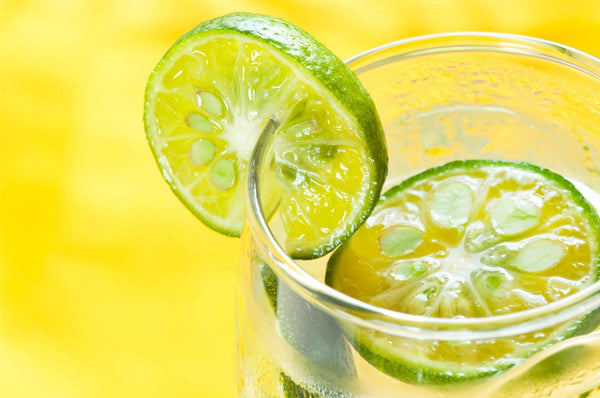
Jump to:
Although part of Japan, Okinawa’s history and climate have meant that Okinawan cuisine has often developed in parallel, rather than integrally, with that of the Japanese mainland. When it comes to citrus fruit, the subtropical climate of Okinawa, characterized by warm temperatures and abundant rainfall, provides optimal conditions for citrus cultivation. The Shikuwasa, which bears similarities to the lime, has a deep significance in Okinawan culture, is nicknamed the “longevity fruit” for its health properties, and even celebrated in local festivals and used as a common motif in Okinawan art and souvenirs. Its bright green color and refreshing taste symbolize the vibrancy of the island’s culture. Harvested from August to February, the juice, peel, and residue of this zesty fruit are processed into a range of products available throughout the year.
The name derives from the Okinawan dialect and is a combination of the two words “Shii” and “kwaasaa”, which mean “sour” and “food” respectively. In this article, we will explore Shikuwasa’s origins, what it tastes like, and discuss its culinary uses. We shall also look at its health and beauty benefits, look at whether it can be cultivated outside of Okinawa, and compare it with other popular citrus fruits.
Origins Of Shikuwasa

Although it is hard to pinpoint when Okinawans first started eating Shikuwasa, its established presence in Okinawan cuisine, where it is a common ingredient in many foods and beverages, folklore, and festivals suggest a history going back many generations. Growing wild in its native Ryukyu islands, and Okinawa in particular, it has long been hailed as a medicine, rather than just a food product, and many attest to the potential health benefits of its tart juice and zest.
Every year, towns and villages in Okinawa hold Shikuwasa festivals where they celebrate the harvest of this citrusy gem with local food stalls, offering dishes and drinks made with Shikuwasa, such as Shikuwasa juice, Shikuwasa-flavored ice cream, and Shikuawa-flavored candy. It also forms part of the Citrus festival, an event highlighting the diversity of citrus fruits in the region, including Shikuawasa, Kabosu, and Yuzu. Shikuwasa is also used as an offering at various religious rituals held throughout the year.
What Does Shikuwasa Taste Like?
So, what does Shikuwasa taste like? It can perhaps be described as a cross between lemons and limes. They are tart like lemons and limes, but the tartness is milder and less intense. The citrus qualities of Shikuwasa have hints of both sweetness and bitterness. In contrast to the strong citrusy aroma of lemons and the sharp, tangy notes of limes, the Shikuwasa has a fresh aroma, which, although citrusy, is also slightly floral.
Using Shikuwasa In Food And Drink

In this section, we will look at how Shikuwasa is used in food and drinks. Starting with food, the juice of Shikuwasa is often used as a marinade for meats and seafood. By adding the juice to soy sauce and Mirin, or mixing it with grated ginger, not only gives a refreshing tang that balances the richness of the grilled meat or seafood, but also serves to tenderize the proteins. The juice can also be used to add a zip to your salad dressings. Try whisking it together with olive oil, a touch of honey or sugar, and salt and pepper. Other savory uses include making a glaze for seafood or adding something different to dipping sauces for Tempura or cold noodles.
Its use in food is not limited to enhancing savory dishes and the tart, citrusy flavor of Shikuwasa can be used to add a delightful twist to some established dessert options. This includes being added to sorbets and jelly, either on its own or in combination with other fruit juices. It can also be included in the custard filling for tarts or the creamy base of the Italian classic Panna Cotta. If you are making a cheesecake, adding the juice or zest of a Shikuwasa to the batter adds a tangy citrus twist to its flavor profile. Last, but not least, it can make a delicious option for people who like citrus-based ice creams.
Shikuwasa is also a welcome addition to both alcoholic and non-alcoholic drinks. Starting with the non-alcoholic variety, you can simply squeeze its juice and add it to water or soda to make Shikuwasa juice. If you want something sweeter, it can be combined with lemon juice, sugar, and water to make a refreshing alternative to regular lemonade. You can also try adding the juice to iced tea or your favorite type of smoothie.
Shikuwasa can make an interesting addition to alcoholic beverages as well, replacing the lime in cocktails like the Mojito or Margarita for a subtle twist on the original recipes, as well as being added to light beers to make a beer cocktail. It also accompanies stronger alcoholic drinks well, including the traditional Okinawan distilled liquor Awamori. Two notable concoctions produced by uniting these unlikely bedfellows are the Shikuwasa Awamori highball, in which Shikuwasa juice and Awamori are mixed with sparkling water or soda over ice, and the Shikuwasa Awamori cocktail, where the juice and Awamori are mixed with syrup or honey and a splash of sparkling wine.
Nutritional Benefits Of Shikuwasa

As mentioned in the introduction, Shikuwasa has been nicknamed the longevity fruit due to its nutritional qualities. The majority of Shikuwasa are grown in Ogimi village, in the Kunigami District, in the northern part of Okinawa island. According to World Health Organization data, the village is said to have the largest concentration of centenarians. Moreover, it has a history of traditional medicinal use in Okinawan folk medicine. These include uses as a cold and sore throat remedy, a digestive aid, a skin care, and as a general tonic promoting overall well-being and vitality. Examined through the lens of modern medicine, Shikuwasa promises the following health benefits:
Rich in Antioxidants
Shikuwasa has high levels of antioxidants, such as vitamin C and flavonoids, which help neutralize free radicals in the body, thus reducing oxidative stress and inflammation. It also has 2.2 times the quantity of citrus acid than lemons, which is effective in fatigue relief.
Anti-Inflammatory Properties
Inflammation in the body is linked to various chronic diseases. Studies suggest that some compounds found in Shikuwasa, such as hesperidin and nobiletin may have anti-inflammatory properties that can counteract the effect of inflammation in the body and help prevent the diseases in question.
Weight Loss Benefits
Shikuwasa peel contains synephrine. This has been shown to be effective in metabolizing lipids, and generally increasing the metabolic rate, which, in turn, promises weight management benefits.
Potential Liver Benefits
There are also studies that suggest that the flavonoids in Shikuwasa help to suppress liver injury. Having a healthy liver is essential for a number of bodily functions such as hormone regulation and the decomposition of red blood cells.
Does Shikuwasa Have Any Cosmetic Benefits?

In addition to being a nutritional powerhouse, Shikuwasa has a number of cosmetic advantages as well. In fact, the oil extracted from Shikuwasa is a common ingredient found in a number of skincare products, including serums, moisturizers, and toners, not to mention various hair care products.
The vitamin C in the fruit helps to brighten the skin as well as reduce hyperpigmentation as well as reduce the impact of dark spots on the skin. Antioxidants help the body to combat free radicals, and this, in turn, assists with anti-aging, protecting against UV and other environmental stressors, such as pollution. Last but not least, some of the compounds in Shikuwasa have natural antibacterial properties that help keep the skin clean and inhibit the growth of harmful bacteria in the body.
Is Shikuwasa An Okinawa-Only Fruit?
Certain factors combine to make Okinawa an ideal place for cultivating Shikuwasa. These include its subtropical climate, with its mild winters and hot and humid summers, the abundance of rainfall that provides sufficient water for Shikuwasa trees throughout the year, the lengthy harvest season, low risk of frost that can be damaging for trees, and its well-drained soil.
In fact, the only place other than Okinawa that produces any meaningful quantity of Shikuwasa is Taiwan, the country from which it was introduced to Okinawa sometime between the 13th and 16th centuries, and where it is knowns as Shikwasa or Hirami lemon. Not surprisingly, Taiwan shares many of the same geographical and weather characteristics of Okinawa. Recently, there are stories of plans to increase the cultivation of Shikuwasa in Taiwan so that they can feed it to livestock and create a Shikuwasa brand of pork.

While there are other citrus fruits that may be similar to the Shikuwasa in both appearance and taste profile, there are some key differences that you should be aware of, which will be discussed below.
Shikuwasa vs Kabosu
The Kabosu is a citrus fruit native to Oita prefecture, on the Kyushu island in Japan. Although slightly larger than the Shikuwasa, the Kabosu also turns from green to yellow when it ripens. While the Shikuwasa has a strong sour taste with a hint of bitterness, the Kabosu offers a flavor that is more balanced between sourness and sweetness. The stronger acidity of the Shikuwasa makes it versatile in cooking, beverages, and beauty products, whereas Kabosu is often used in sauces for hot pots and fried foods.
Shikuwasa vs Sudachi
The Sudachi is a citrus fruit native to Tokushima Prefecture, Japan. Again, although slightly larger than the Shikuwasa, the Sudachi also turns from green to yellow when it ripens. In contrast to the Shikuwasa with its strong sour taste and a hint of bitterness, the Sudachi offers a sharp, tangy flavor with a refreshing aroma. The Sudachi is often used as an accent in dishes like chilled soba, fish dishes, and as a garnish, particularly for its refreshing aroma which enhances the flavors of the ingredients.
Shikuwasa vs Calamansi
The Calamansi is a citrus fruit native to the Philippines. The Calamansi is also larger than the Shikuwasa and turns from green to yellow when it ripens. What differentiates the taste profile of the Calamansi compared to the Shikuwasa, is that it presents a tart and tangy flavor often compared to a mix of lime and orange. The Calamansi is commonly used in Filipino cuisine for flavoring, marinades, and beverages. Its versatile flavor enhances a wide range of dishes, making it a popular ingredient in both savory and sweet recipes.
Shikuwasa vs Yuzu
The Yuzu is a citrus fruit native to East Asia, including Japan, Korea, and China. Although larger than the Shikuwasa, the Yuzu also turns from green to yellow when it ripens (are you seeing a pattern here?). In contrast to the Shikuwasa, which has a strong sour taste with a hint of bitterness, the Yuzu offers a tart, fragrant flavor with a unique aroma that combines elements of lime, lemon, and grapefruit. The Yuzu is often used in Japanese cuisine, especially in sauces, marinades, and as a garnish. Its zest and juice are also popular in beverages and desserts, particularly for its distinctive aroma which enhances the flavors of the ingredients.
Shikuwasa – The Citrusy Super Food From Okinawa

Shikuwasa, the lively citrus gem from Okinawa, is a big deal in local culture and cuisine, celebrated for both its health benefits and distinct flavor. Labeled the “longevity fruit,” it flourishes in Okinawa's warm, subtropical climate, playing a part in the region's impressive health and longevity track record, that singled Okinawa apart as one of the so-called “blue zones”. With a taste that’s tart yet slightly sweet, Shikuwasa is incredibly versatile, enhancing everything from savory marinades and dressings to sweet desserts and drinks. Packed with antioxidants and anti-inflammatory compounds, it brings numerous health benefits like aiding in weight management and protecting the liver against damage, justly earning its plaudits as a superfood. It is not only in nutrition, but also in cosmetic benefits that it shines, and its vitamin C and antioxidants help to keep the skin healthy and youthful. Mostly grown in Okinawa, Shikuwasa stands out from other citrus fruits, making it a true symbol of Okinawan heritage and wellness.
Have you tried the Shikuwasa yet? If so, in what dishes or beverages? Let us know in the comments.


0 comments